




Your support is critical to our success.
Nat. Hist. Bull. Siam Soc. 24: 164 (1971)
Family: CYCADACEAE
Accepted Scientific Name: Cycas simplicipinna (Smitinand) K.D.Hill
Proc. Third Internat. Conf. Cycad Biol. 150 (1995)
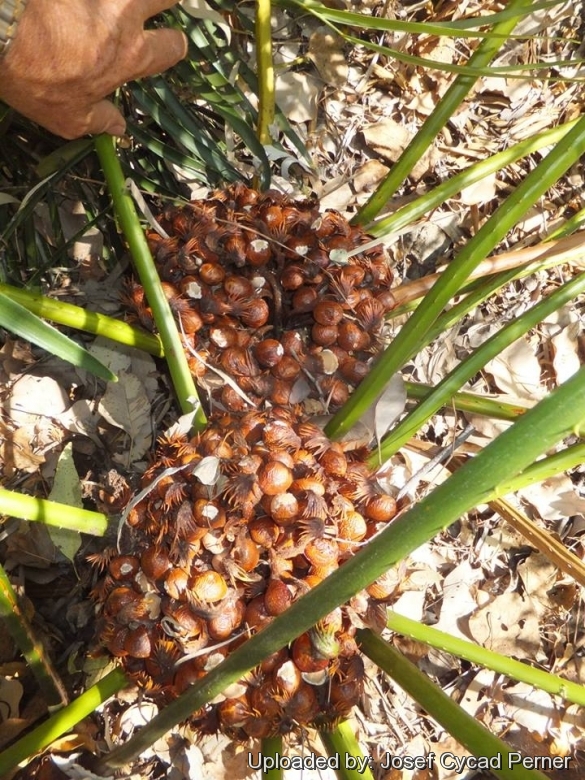
Origin and Habitat: Cycas simplicipinnaSN|31814]]SN|31814]] is known from Yunnan in China, western Quang Tri Province in Viet Nam. Further, it is widely distributed in the mountains of northern Thailand. This species also occurs in northern Myanmar and Laos. The species appears to be usually scattered and sporadic in occurrence with population size estimated to be larger than 10,000 mature individuals, and dense stands are uncommon.
Altitude range: This species is recorded from 600 to 1,300 metres above sea level.
Habitat and Ecology: This species occurs in wetter and more sheltered sites in deep shade in in the understorey of tall closed humid evergreen forests. Individuals are usually scattered and sporadic in occurrence, and dense stands are uncommon. Often occuring near streams. Continued land clearing may become a threat across the vast distributional range of this plant. However many populations remain across this range, with a number in conservation areas, and it is not under any immediate threat of extinction.
Synonyms:
- Cycas simplicipinna (Smitinand) K.D.Hill
- Cycas micholitzii var. simplicipinna Smitinand
CHINESE (中文): 單羽蘇鐵
Description: Cycas simplicipinnaSN|31816]]SN|31814]] is small, trunkless or rarely short- trunked, shrubby cycad to 2.5 m tall. It produces several rather large ascending, pinnate leaves. The plants are dioecious, that is to say that male plants produce pollen by leaf homologues called microsporophylls, and female plants produce ovules by leaf homologues known as megasporophylls, but only one sex is to be found on any one plant so both male and female plants must be grown if seed is required. In all cycads, the microsporophylls are arranged spirally about a cone axis; but Cycas, megasporophylls are similarly arranged. Megasporophylls of Cycas do not form a true cone but are arranged in two to three whorls at the stem apex. Later the stem resumes vegetative growth. The almost totally subterranean habit with the very sparse crown of large, erect leaves with few, broad, well-spaced leaflets and small and narrow male cones immediately distinguish this species from all other Thai cycads. The small megasporophylls with short spines on the apical lamina and small seeds are also distinctive.
In this species The plant is not self-fertile.
Derivation of specific name: From the Latin 'pinna', first division of a compound leaf, with the compound prefix simplici-, simple, referring to the simple leaflets in contrast to the divided leaflets of Cycas micholitziiSN|31814]]SN|31816]], of which this taxon was initially regarded as a variety.
Stem: (7-)8-14(-20) cm diameter, mostly subterranean (acaulescent ) or rarely above-ground and short-creeping, bark nearly smooth, pale grey to yellowish.
Leaves: 2-5 in crown, pinnate, erect to ascending, bright green to deep green, highly glossy, with orange tomentum shedding as leaf expands. Petiole 35-140 cm long (40-60% of total leaf), lateral margins armed with short spines. Rachis 90-250 cm long consistently terminated by paired leaflets. Pinnae (leaflets ), 18-38(-45) on each side of rachis, 20-56(-60) cm long, 1.4-2 cm wide, regularly arranged, remote, 20-40 mm apart on rachis (opposing leaflets inserted at 160-180° on rachis), decurrent for 5-10 mm, lower ones not reducing gradually to spines, 120-300 mm long, midrib raised above. Median leaflets section flat (not keeled) in section. Margins flat or undulate.
Cataphylls: The cataphylls (Modified leaf, much reduced and thickened, serving to protect the apical meristem in cycads produced in flushes preceding the emergence of cones or leaves.) are 4-5 cm long, soft, pilose, and articulated.
Male cones: Small and narrow (15-21 long, 2.2-4 cm in diameter), spindle-shaped, creamy-yellow, microsporophylls 1.2-1.4 long, 0.8-1 cm wide, fertile zone 8-10 mm long, sterile apex 3-6 mm long, raised, apical spine absent.
Female: Globular, megasporophylls 7-12 cm long with brown, felt-like indument. Lamina ovate, 45-55 mm long, 18-35 mm wide, deeply pectinate, margins prominently comb-like,lateral spines 15-25 mm long, 1.5-2 mm wide, apical spine not distinct from lateral spines. Ovules 2, glabrous.
Seeds: 2.5-2.7 long, 1.8-2.1 cm broad, ovoid. Sarcotesta yellow, not pruinose, fibrous layer absent, sclerotesta verrucose. Spongy endocarp absent.
Subspecies, varieties, forms and cultivars of plants belonging to the Cycas micholitzii group
Cycas simplicipinna, Cycas micholitzii, Cycas bifida and Cycas multipinnata forms a group. C. simplicipinna has undivided pinnae, whereas C. micholitzii and Cycas bifida have pinnae that are once dichotomous, and C. multipinnata has pinnae that are two to five times dichotomous. Thus there is a transformation series from simple to dichotomous to multidichotomous. This phenomenon becomes even more interesting when examining the development from seedling to adult of individual plants of C. micholitzii and C. multipinnata. In C. micholitzii, the first leaf has undivided pinnae, the second leaf has one dichotomous pinnae. In C. multipinnata, the first leaf has undivided pinnae, the second leaf has one dichotomous pinnae, the third through fifth leaves have a pinnae where one of the dichotomies is itself dichotomous resulting in a tripartite pinnae, and the sixth and subsequent leaves have pinnae with multiple dichotomies resulting in leaves that have a minimum of three dichotomies per pinna. Thus, we not only have a transformation series between species but also within a species.
 Cycas bifida (Dyer) K.D.Hill: has few arching fronds with long petioles shooting out of a small, dome-shaped caudex and glossy leaflets bifurcated very near to the base. Distribution: China (Guangxi, Yunnan) and northern Viet Nam (Cao Bang, Lang Son and Tuyen Quang).
Cycas bifida (Dyer) K.D.Hill: has few arching fronds with long petioles shooting out of a small, dome-shaped caudex and glossy leaflets bifurcated very near to the base. Distribution: China (Guangxi, Yunnan) and northern Viet Nam (Cao Bang, Lang Son and Tuyen Quang).  Cycas micholitzii Dyer: is mostly stemless with, erect fronds, comparatively short and narrow leaflets are bi-pinnate, in other words they split dichotomously, two or three times, giving a most un-cycad like appearance. Distribution: China, Vietnam and Laos.
Cycas micholitzii Dyer: is mostly stemless with, erect fronds, comparatively short and narrow leaflets are bi-pinnate, in other words they split dichotomously, two or three times, giving a most un-cycad like appearance. Distribution: China, Vietnam and Laos.- Cycas multipinnata C.J.Chen & S.Y.Yang
 Cycas simplicipinna (Smitinand) K.D.Hill: is mostly stemless with large, erect fronds with broad and well-spaced undivided leaflets, small microsporangiate cones, small megasporophylls with short spines on the apical lamina. Distribution: China,Viet Nam and Thailand.
Cycas simplicipinna (Smitinand) K.D.Hill: is mostly stemless with large, erect fronds with broad and well-spaced undivided leaflets, small microsporangiate cones, small megasporophylls with short spines on the apical lamina. Distribution: China,Viet Nam and Thailand.
Bibliography: Major references and further lectures
1) Barbara A. Ambrose, Michael D. Purugganan “Annual Plant Reviews, The Evolution of Plant Form” John Wiley & Sons, 21 November 2012
2) Nguyen, H.T. 2010. Cycas simplicipinna. The IUCN Red List of Threatened Species. Version 2015.2. <www.iucnredlist.org>. Downloaded on 01 September 2015.
3) Donald R. Hodel “The Palms and Cycads of Thailand” Kampon Tansacha, Nong Nooch Tropical Garden, 01 January 1998
4) Boris Lariushin “Cycadaceae Family” Lulu.com
5) V.P. Singh “Gymnosperm (naked seeds plant) : structure and development” Sarup & Sons, 01 January 2006
6) Palms & Cycads: Magazine of the Palm & Cycad Societies of Australia Ltd, Edizioni 58-85 page 1, The Societies, 1998
7) Govaerts, R. “World Checklist of Seed Plants” 3(1, 2a & 2b): 1-1532. Continental Publishing, Deurne. 1999.
8) Averyanov, L.V. & al. “Gymnosperms of Laos.” Nordic Journal of Botany 32: 765-805. 2014.
9) The Cycad Pages “Cycas simplicipinna” Royal Botanic Gardens Sydney Written and maintained by Ken Hill 1998-2010 Maintained by Leonie Stanberg and Dennis Stevenson 2010-2012 <http://plantnet.rbgsyd.nsw.gov.au/cgi-bin/cycadpg?taxname=Cycas+simplicipinna> Web. 25 August 2015
10) Whitelock, Loran M., “The Cycads”, Timber press, 2002.
11) Haynes J.L, “World List of Cycads: A Historical Review”, IUCN/SSC Cycad Specialist Group, 2012
12) Encyclopædia Britannica, Inc. <http://www.britannica.com/plant/cycadophyte#ref411021> Web. 25 August 2015
13) T. Smitinand & K. Larsen “Flora of Thailand: Cardiopteridaceae, Dilleniaceae, Saurauiaceae, Schisandraceae, Illiciaceae, Connaraceae, Apostasiaceae, Actinidiaceae, Theaceae, Bonnetiaceae, Centrolepidaceae, Flagellariaceae, Hanguanaceae, Juncaceae, Lowiaceae, Restionaceae, Triuridaceae, Balanophoraceae, Rafflesiaceae, Cycadaceae, Pinaceae, Cephalotaxaceae, Cupressaceae”, Volume 2, Part 2 Applied Scientific Research Corporation, 1972
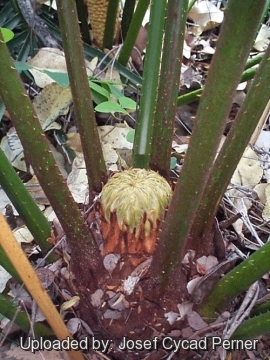
Female, Megasporophylls in developments. (Cycas simplicipinna) Photo by: Josef Cycad Perner
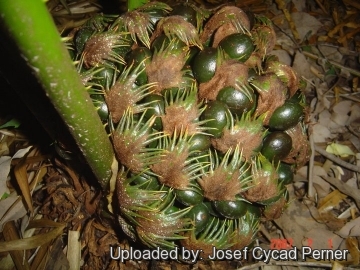
Female, Megasporophylls with immature seeds. (Cycas simplicipinna) Photo by: Josef Cycad Perner
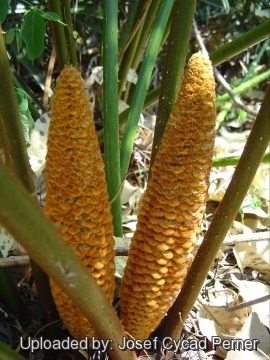
Male cones. (Cycas simplicipinna) Photo by: Josef Cycad Perner
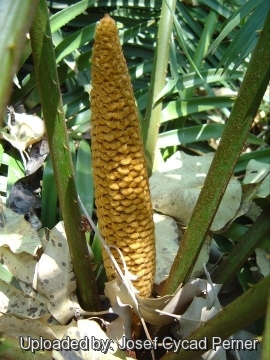
Male cones in this species are small and narrow. (Cycas simplicipinna) Photo by: Josef Cycad Perner

Female with seeds. (Cycas simplicipinna) Photo by: Josef Cycad Perner

Female, Megasporophylls with immature seeds. (Cycas simplicipinna) Photo by: Josef Cycad Perner
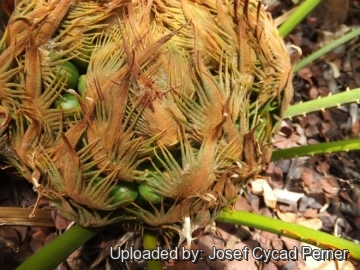
Cycas micholitzii var. simplicipinna (Cycas simplicipinna) Photo by: Josef Cycad Perner
The gallery now contains thousands of pictures, however it is possible to do even more. We are, of course, seeking photos of species not yet shown in the gallery but not only that, we are also looking for better pictures than those already present. Read More...
Cultivation and Propagation: Cycas simplicipinnaSN|31814]]SN|31814]] is suited to tropical regions which have a seasonally dry climate. It is easy to grow, tolerating short dry periods. It is attractive as a young plant because of the elegant feathery fronds. Cycas simplicipinnaSN|31814]]SN|31814]]is suited to pot culture.
Exposure: It prefers bright light exposure to shade, colour bleaches when in full sun, best with protection from afternoon heat.
Soil: Needs a well drained spot, with deep soil, but will still thrive in less than ideal conditions.
Fertilizaton: Because of its growth habit, fertilize only when terminal bud begins to swell, indicating the start of the annual growth cycle.
Maintenance: Minimal; removal of offsets if desired, removal of spent fronds.
Hardiness: This species is probably a tropical in its needs.
Use: Landscape as cultivated perennial in warm, coastal areas. House-plant or interior-scape, as container plant in cool areas.
Warning: Petiolar spines are short and well spaced, but still sharp so take care when pruning.
Propagation: Seed. As a slow growing plant, the seed can take from 6–18 months to germinate. After fertile seeds are collected, they usually need several months of storage before the inner embryo is ready to germinate. Therefore, it is best to clean the seeds of external fruit and set them aside before attempting to propagate the seeds. Usually seeds are ready to germinate after 2-4 month, the germination is rapid and almost all seeds germinate up within 2 month.
| Your Actions | |
|---|---|
| Back to Cycas index | |
| Back to Cycadaceae index | |
 |
Back to Palms And Cycads Encyclopedia index |
Privacy stantement - Terms and conditions - How to cite - About us - Feedback - Donate


